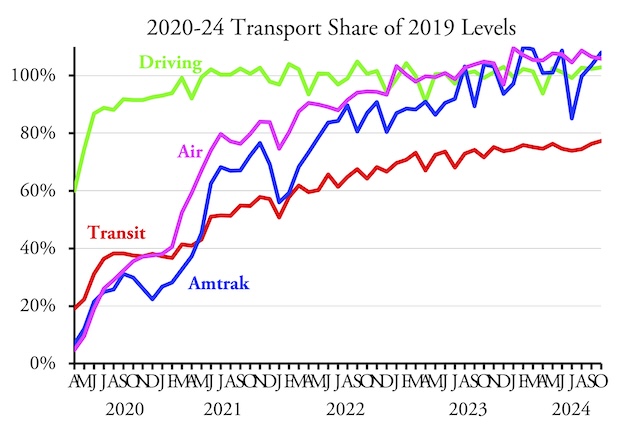Americans drove 2.8 percent more miles in October 2024 than the same month before the pandemic, according to data released by the Federal Highway Administration last Friday. Both urban and rural driving were greater in October 2024 than October 2019.
Meanwhile, Amtrak brags that it carried an all-time record number of passengers in its fiscal year 2024 (which ended September 30). In that year, it carried 32.8 million riders and 6.54 billion passenger-miles. That is only a small fraction of the number carried by passenger trains when they were private, as ridership peaked at 1.2 billion in 1920 and passenger-miles peaked at 89 billion in 1944. But 2024 was a record year since Amtrak began in 1971.
You know who else set records? The domestic airlines, which in F.Y. 2024 carried more passengers and more passenger-miles than any previous year. Airlines also carried a record number of international passengers. Though international passenger-miles was not quite a record, the total of domestic and international air passenger-miles did set a record.
Domestic flights carried 848.6 million passengers and 796.6 billion passenger-miles in F.Y. 2024. That’s 26 times as many passengers and 122 times as many passenger-miles as Amtrak. Add in international flights to or from the U.S. and passengers total nearly 1.1 billion and passenger-miles nearly 1.6 trillion. That’s 33 times as many passengers and 243 times as many passenger-miles as Amtrak.
To carry as many passengers as it did, Amtrak required subsidies that were significantly greater than the fares paid by the passengers. Amtrak riders paid $2.5 billion in fares and for food and beverages, which works out to about 38¢ per passenger-mile. Meanwhile, Amtrak spent $4.3 billion on direct operating costs (66¢ per passenger-mile), and when depreciation and other indirect costs are added the total was more than $6.1 billion (94¢ per passenger-mile), thus requiring an operating subsidy of 56¢ per passenger-mile. This doesn’t even count Amtrak’s capital expenditures of $4.5 billion (68¢ per passenger-mile). (All these numbers are from Amtrak’s September performance report.)
We don’t have airline subsidies for 2024 yet, but counting just domestic air travel they averaged 1.1¢ per passenger-mile in 2019. With depressed travel this increased to 4.9¢ per passenger-mile in 2021, but should be back down to about a penny in 2024. Of course, I object to subsidies to all forms of travel, but ending subsidies to air travel would increase ticket prices by only about 5 percent while ending subsidies to Amtrak would triple or quadruple rail fares. Which do you think would have the greatest impact on their businesses?
You know what else set a record in 2024? Highway travel. In F.Y. 2024, American highways carried 3.28 trillion vehicle-miles of travel, more than any previous year in history. The previous record of 3.27 trillion had been set in 2019. If the average vehicle carried 1.52 people, as calculated by the 2022 National Household Travel Survey, highways moved 4.99 trillion passenger-miles, more than 760 times as many as Amtrak.
Highways are subsidized (mainly local roads), but because they carry so much travel the subsidies average only about a penny per passenger-mile. Ending the subsidies would increase the costs of driving by about 4 percent, which would have a much smaller impact on auto travel than ending the subsidies to Amtrak would have on rail travel.
The Census Bureau estimates that the U.S. currently has about 337 million residents. If so, then highways carried the average resident 14,800 miles; domestic air flights carried the average resident 2,360 passenger-miles; and Amtrak carried the average resident 19 passenger-miles. For the record, public transit carried the average resident 115 passenger-miles while intercity buses probably carried residents about 50 or 60 passenger-miles.
So congratulations to Amtrak for hanging on to its 0.1 percent share of U.S. passenger travel. Its ridership may grow as it uses the money Congress gave it in 2021 to add new routes, but it will still never amount to more than a rounding error in total U.S. travel.









The average American takes a one-way trip on Amtrak once every 10.3 years (a round trip once every 20.5 years), but pays $10.27 to subsidize Amtrak and $13.35 to expand it, for a total of $23.62.
Amtrak is the epitome of concentrating the benefits and dispersing the costs.
Why are taxpayers forced to waste money on sidewalks? The passenger miles must be neglible. That money could better be spent on subsidized automobiles for anyone who currently walks somewhere, increasing mobility and efficiency.
in many of the developments in the southeast now I understood developers would begin to take on sidewalks. anyway….where i live in Virginia its my duty to keep ice of a sidewalk that borders my residence that I didn’t build or request.
Anti-car urbanists often complain about how allocating land to parking is a poor use of valuable space within cities, but we could eliminate a lot of the need for parking if we fewer people walked in cities in the first place. The only reason we need parking is that people are getting out of their cars and walking somewhere (say, into a business like an office to work or a restaurant to eat).
Instead, we should encourage more restaurants, bars and offices to be drive-through. Serving customers in their cars mean that the customers don’t need to park, obviating the need for parking! Similarly, employees could drive into their office and work within the comfort of their automobile.
And the same goes for residences – imagine not needing to park your car and walk into your home – instead, you simply drive into your home and eat, sleep, watch TV, entertain guests, make love, etc., all within the comfort of your car.
as a former delivery driver i used and appreciated drive thrus for lunch
sthomper, I’m told that some people have to leave their vehicles to eat lunch. It’s sad but fortunately it’s been in decline for decades.